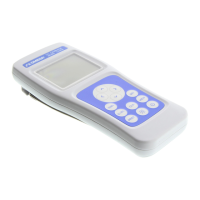2-2
Safety Notices and Information
Read this Operation Manual thoroughly before using the instrument to become familiar with its
operations and capabilities.
Visually inspect instrument before using. Do not use if unit appears damaged or with any part of the
case removed.
WARNING
MAINTENANCE INSTRUCTIONS WITHIN THIS MANUAL ARE FOR USE BY QUALIFIED SERVICE
PERSONNEL ONLY. DO NOT ATTEMPT TO SERVICE THIS UNIT UNLESS YOU ARE QUALIFIED TO DO
SHOCK HAZARD
Disconnect all temperature probes and turn the unit off before removing the battery cover.
Never connect thermocouple leads to any source where more than 42 Volts (peak) could exist
between the lead and ground. If it is necessary to make measurements of an object at elevated
electrical potential, the user is responsible for obtaining and properly using a probe that provides
adequate insulation between the surface with elevated potential and the thermocouple wiring.
Always disconnect probe leads before opening the battery door or the instrument housing.
Internal circuits can present a shock hazard if leads are connected to a source of elevated potential.
Do not use this instrument if the housing, probe wiring, probe, or probe handle are damaged
or distorted. Housings and wire insulation are part of the personnel protection system, and if damaged
could expose users to elevated potentials.
EXPLOSION HAZARD
Never use or store this product with batteries installed, or change batteries, in an
environment where explosive or flammable vapors or dust suspensions may exist. For
thermocouple thermometers suitable for use in explosive environments, see Error! Reference source
not found.’s 921A or 922A Intrinsically Safe Thermometers.
Do not attempt to recharge alkaline batteries.
Do not put batteries into bags designed to protect parts from electrostatic discharge (ESD).
These bags are specially designed with metal shielding which can short circuit a battery.
Do not expose batteries to extreme heat or fire. Observe all regional laws and regulations when
disposing batteries.
Never use this instrument or any temperature probe or sensor inside a microwave oven.
BURN HAZARD
Do not touch a temperature probe sheath that has been exposed to toxic substances or
extremely high or low temperatures.
Do not attempt to measure temperatures beyond the range of the temperature probe. Probe
damage or personal injury could result from exceeding a probe’s maximum temperature rating.
Safety Notices and Information continued on next page . . . .

